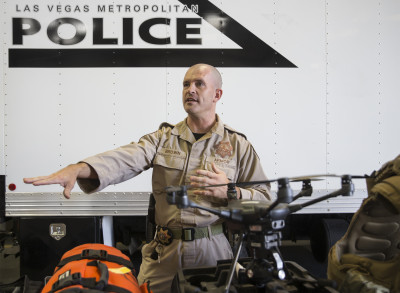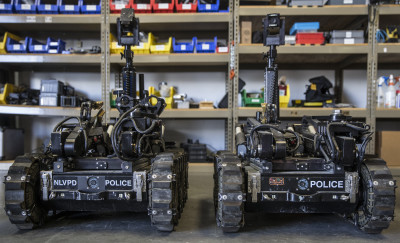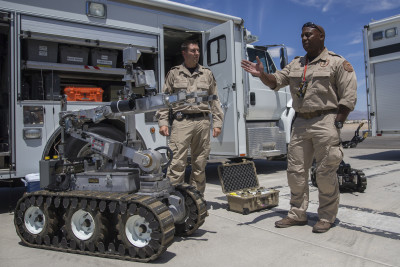Soon after the 9/11 attacks, letters laced with deadly anthrax bacteria were sent in the United States, terrorizing an entire nation.
By Oct. 10 that year, Southern Nevada had one of its first “white powder” scares after a leaking packet of Crystal Light drink mix drew the FBI to the Winterwood post office at Nellis Boulevard and Vegas Valley Drive. In the following weeks, Clark County dispatchers would receive more than 800 calls related to anthrax concerns, the Las Vegas Review-Journal reported at the time, throwing state and local officials into a scramble to develop a plan to properly handle such reports.
“We got tons of white powder letters. We were just constantly going out on these white powder calls,” Metropolitan Police Department officer Roger Haskins recalled last week. “Let’s face it, as a patrol officer, what are you going to do? There was no good answer.”
The answer, funded by grants from the Department of Homeland Security, came about four years later, when Metro’s All-Hazard Regional Multi-agency Operations and Response team — better known as ARMOR — debuted in 2005.
“It was four guys, a robot and a box truck,” Haskins told the Review-Journal in late July during ARMOR’s first exclusive media interview in more than a decade. Haskins was part of the original ARMOR team and is now the senior member of the unit.
 Metropolitan Police officer Gabriel Brown discusses the resources used at the All-Hazard Regional Multi-Agency Operations and Response unit headquarters on Tuesday, July 30, 2019, in North Las Vegas. (Benjamin Hager/Las Vegas Review-Journal) @benjaminhphoto
Metropolitan Police officer Gabriel Brown discusses the resources used at the All-Hazard Regional Multi-Agency Operations and Response unit headquarters on Tuesday, July 30, 2019, in North Las Vegas. (Benjamin Hager/Las Vegas Review-Journal) @benjaminhphotoThe task force brings together law enforcement agencies across Southern Nevada — including Las Vegas, North Las Vegas and Henderson police and the Nevada Department of Public Safety — to detect, mitigate and investigate chemical, biological, radiological, nuclear and explosive incidents. It is one of the few teams of its kind in the United States, often drawing attention from other countries trying to re-create the unit. Brazilian officials, for example, met with ARMOR ahead of the 2014 World Cup, according to Haskins.
The unit even deploys out of state, going as far as Arizona and Southern California in some cases.
It is unlike any traditional hazardous materials response team in that ARMOR “investigates for criminal prosecution,” said Metro officer Gabriel Brooks Brown, who has been with ARMOR for about four years.
“Ultimately, we’re going for prosecution,” he explained. “It’s not just mitigating at a scene. We want to know who did it, why they did it and put them in prison.”
Unique roles
Since 2005, the team has expanded to an 11-person unit with an army of supporting robots. Each person on the team brings a unique set of skills and knowledge to the table.
Officer Patrick Halligan of the investigations division for the Department of Public Safety, for example, is the “tech guy.” He maintains the robots and gear and is one of the most skilled robot operators on the squad.
“I think what we’ve realized is that throughout the country a lot of departments have a group that does chemistry, a group that does biology and a group that does radiation,” he said. “But to put everybody on the same page is pretty unique, having a team working across all disciplines.”
Their “tactical guy” is Wavie Reed, who has been a Henderson SWAT officer for 15 years and joined ARMOR about six years ago.
Halligan and Reed take pride in their respective specialties, often joking during the recent interview about which area is most important. Still, both agree ARMOR is as successful as it has been, in part because of the technological advances the team has seen since its debut.
“It’s given us the ability to do things safer,” Reed said. “I think our technology allows us to be able to do a job probably the safest of all the agencies that are usually involved in an investigation.”
Jumping in, Haskins added, “When we started we used a lot of military technology. It has definitely gotten smaller, and it’s gotten faster, and it’s gotten much more accurate.”
 ICOR MK3 tactical robots at Metro's All-Hazard Regional Multi-Agency Operations and Response headquarters on July 30 in North Las Vegas. (Benjamin Hager/Las Vegas Review-Journal) @benjaminhphoto
ICOR MK3 tactical robots at Metro's All-Hazard Regional Multi-Agency Operations and Response headquarters on July 30 in North Las Vegas. (Benjamin Hager/Las Vegas Review-Journal) @benjaminhphotoMost, if not all, of the unit’s response trucks, some of which serve as mobile command posts, will contain nearly every piece of detection and testing equipment needed to respond to a call safely.
Even the cyborgs on the team have their own special roles. The smaller bots can fit down the aisle of an airplane and can be used to communicate with barricaded suspects during a crisis negotiation, while the unit’s largest robot can pick up explosives or knock down a door.
“The small robots will fit between the coffee table and couch. The big robot will crush the coffee table and the couch,” Haskins said, chuckling.
‘Low frequency, high impact’
The way the team puts it, ARMOR is the “insurance policy” of Southern Nevada law enforcement. They are, after all, responsible for protecting the air we breathe and preventing terrorist attacks.
“We’re low frequency, high impact,” said Brown, one of the Metro officers. “You pay a premium for the coverage, but when you get rear-ended, you’re glad to have it.”
Their job takes them into some of the most dangerous situations imaginable. Like when ricin — a deadly toxin derived from castor beans — was discovered this year in an apartment near West Flamingo Road and South Decatur Boulevard, after a man had died of a heroin overdose. Or recently, when a grenade was found in a thrift store donation box. It looked like a World War II-era training grenade, but it was ARMOR’s job to determine that.
“A lot of what we see isn’t malicious or criminal. Sometimes it’s found property,” said Reed, the Henderson SWAT officer. “But in this job, I will say that you see for yourself what people are truly capable of. I think that is kind of the most bizarre thing about this job.”
ARMOR officers still have fun on the job.
On one of Brown’s first calls after joining the unit, Halligan, the Department of Public Safety officer, told him, “You’re never going to learn how to use the robots unless you just use them.”
So he took control of one of their robots, guiding it through a messy bedroom during a search. But he got one of the wheels caught on a bra strap, sending the cyborg down a flight of stairs.
“I never lived that down,” he recalled in July, laughing.
We’re low frequency, high impact. You pay a premium for the coverage, but when you get rear-ended, you’re glad to have it.
Gabriel Brown, Metro Police Department
More recently, ARMOR got a call from a Strip hotel after a housekeeper found what looked like two copper pipes sealed together at the ends.
It turns out it was a holistic and alternative form of medicine “that absorbs bad aura,” Halligan said, smiling. “You put it under your pillow at night and it gives off good vibes, apparently.”
At the end of the day — no matter if their assignments have “good vibes” or a “bad aura” — Haskins, Reed, Brown and Halligan agree on one thing: They wouldn’t mind being part of the ARMOR unit until retirement.
Contact Rio Lacanlale at rlacanlale@reviewjournal.com or 702-383-0381. Follow @riolacanlale on Twitter.



